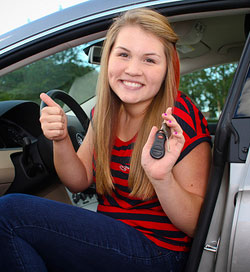Teen Turning 16? 5 Tips For Safe Driving

It’s a tad unsettling to think about a teenager who can’t even wake himself up in the morning suddenly wanting the privilege to drive. You have to weigh your child’s responsibility and maturity to decide if he or she is ready to drive. It’s not a decision to take lightly. The CDC claims that teen drivers are four times likelier to crash than older drivers. Moreover, the National Highway Traffic Safety Administration (NHTSA) reports that motor vehicle accidents are the second leading cause of death for teens. Although these statistics aren’t exactly comforting, there are some ways you can exercise your role as a parent to ensure at least one safe teen driver in the world.
DO set specific rules
Instead of “don’t use your phone while driving,” set rules like “leave your phone in the backseat at all times while driving.” The whole “no driving after dark” is another vague rule that teens can easily rationalize, so be sure to name specific times that your teen has to stop driving. The International Institute for Highway Safety provides a map guide to driving restrictions for teens in all states. For example, New Jersey has a night restriction from 11 p.m. until 5 a.m. while Delaware is 10 p.m. until 6 a.m. Know the laws in your state and use those as guidelines to set specific rules for your child.
Teens are more susceptible to distracted driving and speeding. Their attention spans, motor skills and brain development are not that of an adult. The National Institute of Mental Health reported that a teen brains do not resemble that of an adult’s until they are in their early 20s. These regulations are there to protect these undeveloped young adults. Be candid with your child and explain the importance of rules and how following them can save his or her life.
DON’T be afraid to pass on the teaching task
There’s always that added sentiment of teaching your own child to drive that some parents can’t let go of: it’s how you learned and how your parents learned, and so on and so on. Even though it might feel like a rite of passage to teach your own child to drive, sometimes it’s best for both of you to pass that on to an expert at her school’s driver’s ed program. But don’t worry, you’ll have plenty of opportunities to criticize his driving skills after the program.
DO encourage personal responsibility
Your teen is probably sick of hearing it by now, but driving is a privilege and not a right. Encourage your son or daughter to take responsibility for their driving privileges by having them pay for their own gas and maintenance. Not many teens can afford car insurance, but there are companies that offer discounts for students with good grades. This will encourage your kids to do well in school and keep a clean driving record.
DON’T limit driving experience
The National Safety Council says that inexperience is the leading cause of teen crashes. Even though it might seem practical to keep your teen away from the wheel as often as possible, practice is crucial for your teen to improve her driving skills. Start off small in parking lots and quiet neighborhoods, then eventually move on the busy state roads and highways. Make sure to gradually add in practice at night and in inclement weather as well.
DO teach emergency maintenance
Before your teen begins driving on his own, he should thoroughly understand how to change a tire, how to test the oil and coolant levels, and how to jumpstart a battery. Teens can often forget the maintenance required to keep their cars safe and fully functional, so make sure they’re constantly aware of these needs.
As scary as it might be for a parent, actively playing a role in your teen’s driving career is the best thing you can do to ensure his or her safety. Do all that you can with these five tips, and make sure to keep an open line of communication with your teen to make driving a real learning experience for you both.
Cover photo from State Farm Flickr.




